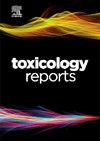Health impacts and risk assessment of PM2.5 and PM10 at Suburban Site in Pathum Thani, Thailand
Q1 Environmental Science
引用次数: 0
Abstract
The aim of this study was to evaluate the carcinogenic and non-carcinogenic health risks associated with heavy metals in PM₂.₅ and PM₁₀ through inhalation exposure among children and adults during both the summer and wet seasons in the Pathum Thani Province, Thailand. PM2.5 and PM10 samples were collected using a Tisch TE-Wilbur sampler, and elemental concentrations were analyzed using Proton-Induced X-Ray Emission (PIXE). Microsoft Excel was employed to determine the statistical values of PM₂.₅ and PM₁₀ concentrations, the concentrations of twelve elements, including Si, S, Cl, K, Ca, Ti, Cr, Mn, Fe, Zn, Ni, and Cu. The enrichment factor (EF), as well as health risk assessment indicators, including target hazard quotient (THQ), hazard index (HI), and carcinogenic risk (CR), were evaluated. The results showed that EF values for Zn, Ni, and Cu ranged from 10 to 100, indicating contributions from anthropogenic sources. Cr exhibited the highest EF values, ranging from 51 to 111, suggesting significant influence from industrial activities and traffic emissions. The mean PM₁₀ concentration (86.0504 µg/m³) during the wet season exceeded the WHO and EU standards but remained below the Thailand standard and the U.S. EPA limit. In contrast, the mean PM₂.₅ concentration (77.5143 µg/m³) during the same period exceeded all referenced standards. The calculated HI values were from 0.0459 to 0.1090 for adults and 0.3285–0.7811 for children. The CR values in PM₂.₅ ranged from 5.0884 × 10⁻⁸ to 7.9544 × 10⁻⁶ for adults and from 5.9364 × 10⁻⁸ to 9.2802 × 10⁻⁶ for children. For PM₁₀, the CR values ranged from 5.1865 × 10⁻⁸ to 1.0412 × 10⁻⁵ for adults and from 6.0509 × 10⁻⁸ to 1.2148 × 10⁻⁵ for children. Although both carcinogenic and non-carcinogenic risks were within acceptable limits, higher risk values were observed in children compared to adults. Therefore, targeted and effective air pollution control policies are recommended, with a particular emphasis on protecting children’s health and strengthening evidence-based air quality management strategies.
泰国巴吞他尼郊区站点PM2.5和PM10的健康影响及风险评估
本研究的目的是评估与pm2.5中重金属相关的致癌和非致癌健康风险。在泰国巴吞他尼省的夏季和雨季,儿童和成人通过吸入接触₅和PM₁₀。使用Tisch TE-Wilbur采样器收集PM2.5和PM10样品,并使用质子诱导x射线发射(pxie)分析元素浓度。采用Microsoft Excel计算PM₂的统计值。₅和PM₁₀浓度,12种元素的浓度,包括Si, S, Cl, K, Ca, Ti, Cr, Mn, Fe, Zn, Ni和Cu。对富集因子(EF)、目标危害商(THQ)、危害指数(HI)、致癌性风险(CR)等健康风险评价指标进行了评价。结果表明,Zn、Ni和Cu的EF值在10 ~ 100之间,表明人为源的贡献。Cr表现出最高的EF值,范围在51 ~ 111之间,表明工业活动和交通排放的影响显著。雨季PM₁₀平均浓度(86.0504 µg/m³)超过世卫组织和欧盟标准,但仍低于泰国标准和美国环保署限值。相反,平均PM 2。在同一时期,₅浓度(77.5143 µg/m³)超过了所有参考标准。成人计算HI值为0.0459 ~ 0.1090,儿童计算HI值为0.3285 ~ 0.7811。在PM₂中的CR值。₅范围从5.0884 × 10⁻⁸到7.9544 × 10⁻⁶(成人),从5.9364 × 10⁻⁸到9.2802 × 10⁻⁶(儿童)。对于PM₁₀,其CR值从5.1865 × 10⁻⁸到1.0412 × 10⁻(成人),从6.0509 × 10⁻(儿童)到1.2148 × 10⁻(儿童)。虽然致癌性和非致癌性风险均在可接受范围内,但观察到儿童的风险值高于成人。因此,建议制定有针对性和有效的空气污染控制政策,特别强调保护儿童健康和加强循证空气质量管理战略。
本文章由计算机程序翻译,如有差异,请以英文原文为准。
求助全文
约1分钟内获得全文
求助全文
来源期刊

Toxicology Reports
Environmental Science-Health, Toxicology and Mutagenesis
CiteScore
7.60
自引率
0.00%
发文量
228
审稿时长
11 weeks
 求助内容:
求助内容: 应助结果提醒方式:
应助结果提醒方式:


